Swainson’s Thrush
The Swainson’s Thrush has become alarmingly rare throughout the Sierra Nevada. They have become extirpated from many locations where they were formerly regularly breeding summer residents, such as Yosemite Valley (Gaines 1988) and Whitaker’s Forest (Marshall 1988). As elsewhere in the Sierra, they were once considered “fairly common” breeders at Lake Tahoe (Orr and Moffitt 1971), and Linsdale (1936) reported this thrush as being common around their camp at Incline Village in June 1931; yet we know of very little current or recent evidence for breeding from the Sierra Nevada region (Small 1998), particularly south of Yuba Pass.
What caused these declines? What is the current breeding status and distribution in the Sierra Nevada? In 2009, TINS biologist Will Richardson found a small concentration of territorial Swainson’s Thrushes in Ward Canyon, on the California side of the Tahoe basin. Several pairs of apparent breeders and two old nests were found, the first documented evidence of nesting in Tahoe in many decades.
The Tahoe Institute of Natural Science has partnered with the Point Reyes Bird Observatory to initiate and maintain a database on Swainson’s Thrush in the Sierra Nevada. Initial efforts will be focused on compiling spatially-explicit data on breeding status for this species. Secondary efforts will be to monitor breeding populations and study them in greater depth (assess demographic parameters, habitat considerations, etc.), starting with the Ward Canyon population in 2010. Thanks to generous grants from the Sierra Foothills and Sacramento Audubon Society chapters, we deployed optical geolocator and GPS units on breeding birds in 2014-5, to determine migratory pathways and wintering grounds for this enigmatic population. Results from that study were published in 2020.
Please contact Will Richardson for more information, or to report a territorial Swainson’s Thrush in the Sierra Nevada.
REFERENCES:
Gaines, D. 1988. Birds of Yosemite and the East Slope. Artemisia Press, Lee Vining, California.
Linsdale, J. M. 1936. The birds of Nevada. Pacific Coast Avifauna 23:1-145.
Marshall, J. T. 1988. Birds lost from a giant sequoia forest during fifty years. Condor 90:359-372.
Orr, R. T., and J. Moffitt. 1971. Birds of the Lake Tahoe Region. California Academy of Science, San Francisco, CA.
Small, S. L. 1998. Swainson's Thrush (Catharus ustulatus) In The Riparian Bird Conservation Plan: a strategy for reversing the decline of riparian-associated birds in California. California Partners in Flight. <http://www.prbo.org/calpif/htmldocs/riparian_v-2.html>. Accessed 12 November 2008.
Swainson’s Thrush color-banded for territory mapping
We have found that populations from a relatively small region in northern California use dramatically different wintering areas


